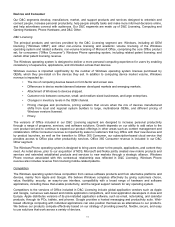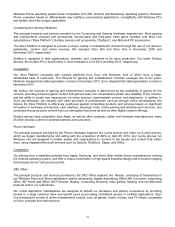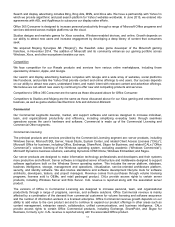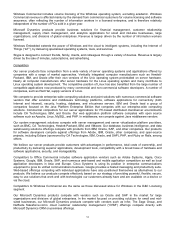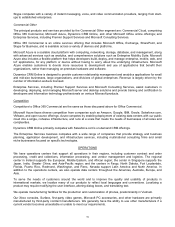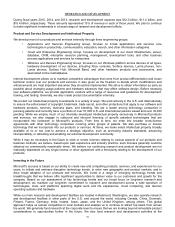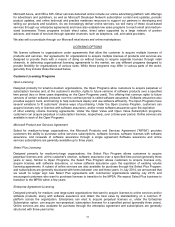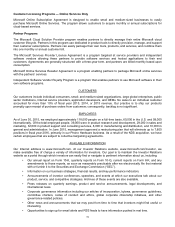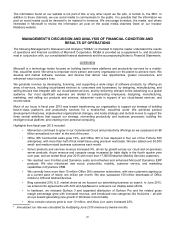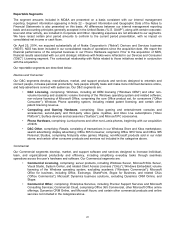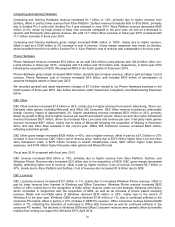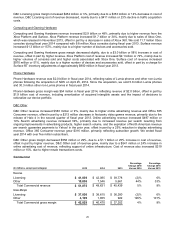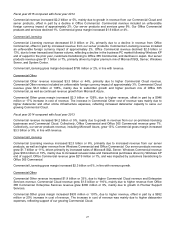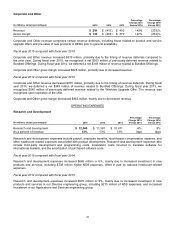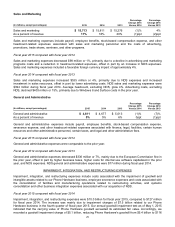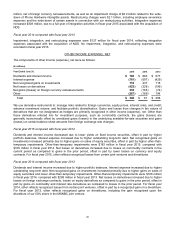Microsoft 2015 Annual Report Download - page 22
Download and view the complete annual report
Please find page 22 of the 2015 Microsoft annual report below. You can navigate through the pages in the report by either clicking on the pages listed below, or by using the keyword search tool below to find specific information within the annual report.21
• We shipped over 36 million Lumia units, and announced the restructuring of our Phone Hardware
business to run it more effectively near-term while driving reinvention longer term.
• We completed 16 acquisitions, including Mojang Synergies AB (“Mojang”), the Swedish video game
developer of the Minecraft gaming franchise, and others, to strengthen our cloud platform and invest in
mobile applications.
• We advanced Windows 10 to the threshold of its launch in July 2015 with the help of the Windows Insider
Program, a new paradigm to incorporate unprecedented levels of user and developer feedback in our
development process.
Industry Trends
Our industry is dynamic and highly competitive, with frequent changes in both technologies and business models.
Each industry shift is an opportunity to conceive new products, new technologies, or new ideas that can further
transform the industry and our business. At Microsoft, we push the boundaries of what is possible through a broad
range of research and development activities that seek to identify and address the changing demands of customers,
industry trends, and competitive forces.
Economic Conditions, Challenges, and Risks
The market for software, devices, and cloud-based services is dynamic and highly competitive. Our competitors are
developing new software and devices, while also deploying competing cloud-based services for consumers and
businesses. The devices and form factors customers prefer evolve rapidly, and influence how users access services
in the cloud, and in some cases, the user’s choice of which suite of cloud-based services to use. We must continue
to evolve and adapt over an extended time in pace with this changing environment. The investments we are making
in devices and infrastructure will increase our operating costs and may decrease our operating margins.
Our success is highly dependent on our ability to attract and retain qualified employees. We hire a mix of university
and industry talent worldwide. Microsoft competes for talented individuals globally by offering an exceptional working
environment, broad customer reach, scale in resources, the ability to grow one’s career across many different
products and businesses, and competitive compensation and benefits. Aggregate demand for our software, services,
and devices is correlated to global macroeconomic and geopolitical factors, which remain dynamic.
Our international operations provide a significant portion of our total revenue and expenses. Many of these revenue
and expenses are denominated in currencies other than the U.S. dollar. As a result, changes in foreign exchange
rates may significantly affect revenue and expenses. Recently, the significant strengthening of the U.S. dollar relative
to certain foreign currencies has negatively impacted reported revenue and reduced reported expenses from our
international operations.
See a discussion of these factors and other risks under Risk Factors in our fiscal year 2015 Form 10-K.
Seasonality
Our revenue historically has fluctuated quarterly and has generally been highest in the second quarter of our fiscal
year due to corporate calendar year-end spending trends in our major markets and holiday season spending by
consumers. Our Computing and Gaming Hardware segment is particularly seasonal as its products are aimed at the
consumer market and are in highest demand during the holiday shopping season. Typically, the Computing and
Gaming Hardware segment has generated approximately 40-50% of its yearly revenue in our second fiscal quarter.
Unearned Revenue
Quarterly and annual revenue may be impacted by the deferral of revenue, including:
• Revenue deferred on pre-sales of Windows to original equipment manufacturers (“OEMs”) and retailers
before general availability.
• Revenue deferred on bundled products and services (“Bundled Offerings”).
• Revenue deferred on sales of Windows 7 with an option to upgrade to Windows 8 Pro at a discounted
price (the “Windows Upgrade Offer”).
If our customers choose to license cloud-based versions of our products and services rather than licensing
transaction-based products and services, the associated revenue will shift from being recognized at the time of the
transaction to being recognized over the subscription period or upon consumption, as applicable.


